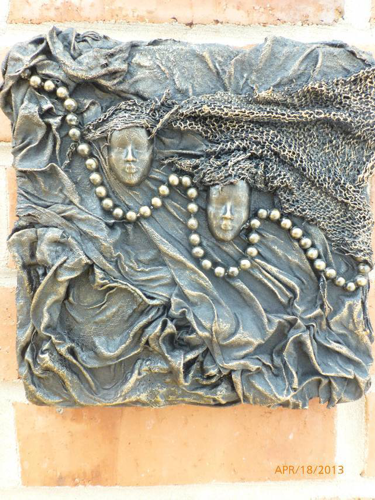What I had in mind when I started this post was sculpture that features flowing, stiffened fabric. After visiting many webpages and gathering enough URLs for two related posts, I came across the correct term for finding what I was looking for--hardened fabric sculpture. Time and conditions permitting, I'll be able to work with this technique this summer.
In the meantime, gathering information is the order of the day. Here are some images of what's in mind.
Some products used to harden the fabrics are Paverpol and Fa-Brick. A note on the Paverpol site says:
The video below shows how to use a fabric hardener. Be aware that she's using very small pieces of fabric and her method is not very economical. Seems to me the excess hardener should be scraped off. Also, the Helmar product is a glue and mainly used for crafts.
As you can see, the process is pretty messy.
If you're planning on creating free-standing sculptures, an armature is a good idea. You can buy them ready-made or construct your own (video below). Note that he's using metal pipe. If what you're hanging on the armature is fairly light (fabric usually is), PVC pipe should work. No promises, though. There are two things to keep in mind: if the armature fails, the work sags or even collapses and the final weight of the piece (metal is heavier than PVC). Seems like some experimentation may be needed.
-- Marge
In the meantime, gathering information is the order of the day. Here are some images of what's in mind.
***
 |
| Robyn, "Bedouin-Nomad," VivyGirl Designs |
***
 |
| Terry Kruse, "Ricki," Terrys art |
***
 |
| Tracey Evans, Wall Plaque, Folksy |
***
Some products used to harden the fabrics are Paverpol and Fa-Brick. A note on the Paverpol site says:
IMPORTANT: DO NOT pour Paverpol down your drain – keep a bucket of water at your workstation and rinse hands and brushes frequently. While Paverpol is water-based and non-toxic, it is made to cure rock-hard, and you don’t want it stuck in your plumbing. Periodically clean the bucket; let the material in the water settled, pour off the water into flower garden, etc. The solids that have collected at the bottom of the bucket can be disposed of in any trash receptacle.Other substances can be used to harden fabric, such as starch, wood glue, and epoxy resin. But I recommend using one of the commercial products because they are weather-resistant, can be installed outdoors, and are non-toxic. No mention of UV-resistance.
The video below shows how to use a fabric hardener. Be aware that she's using very small pieces of fabric and her method is not very economical. Seems to me the excess hardener should be scraped off. Also, the Helmar product is a glue and mainly used for crafts.
***
***
As you can see, the process is pretty messy.
If you're planning on creating free-standing sculptures, an armature is a good idea. You can buy them ready-made or construct your own (video below). Note that he's using metal pipe. If what you're hanging on the armature is fairly light (fabric usually is), PVC pipe should work. No promises, though. There are two things to keep in mind: if the armature fails, the work sags or even collapses and the final weight of the piece (metal is heavier than PVC). Seems like some experimentation may be needed.
***
***
-- Marge

No comments:
Post a Comment